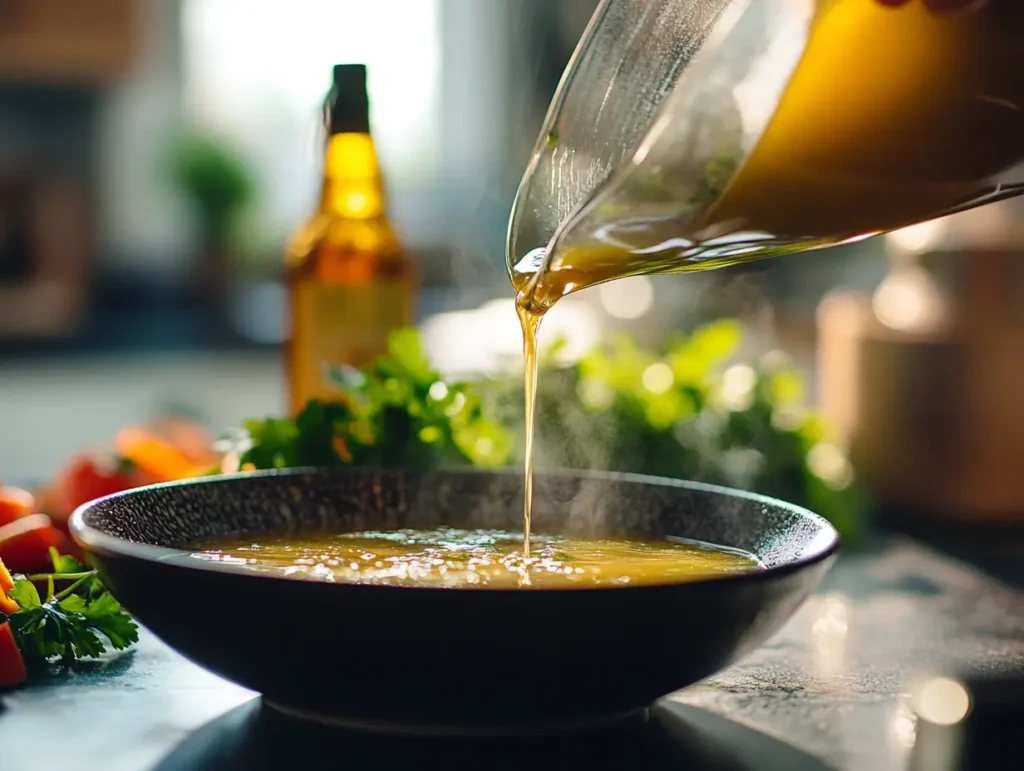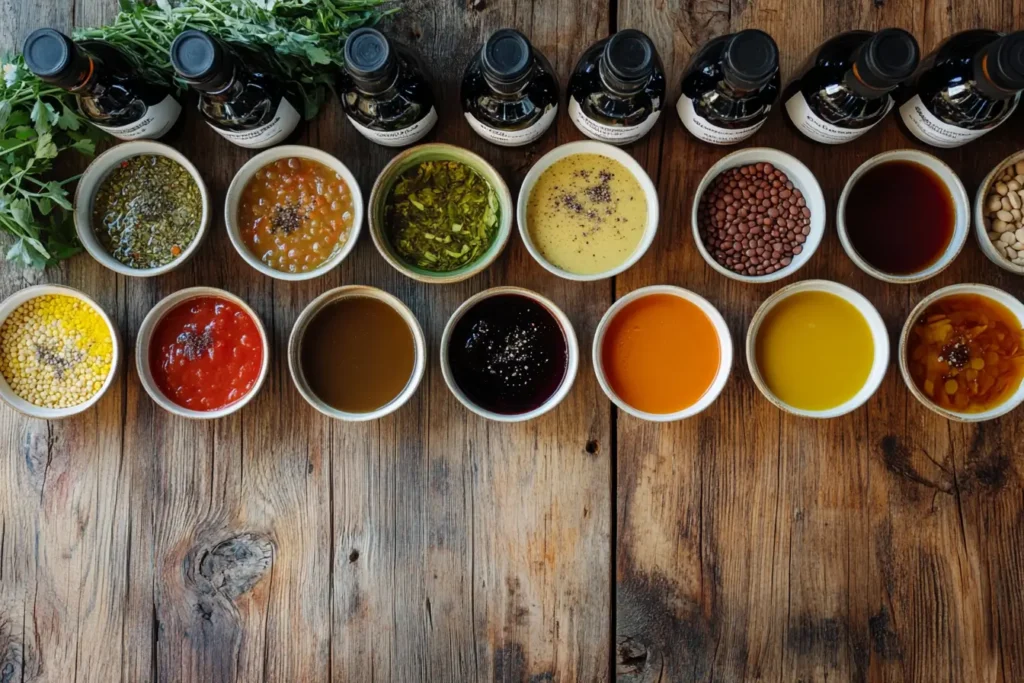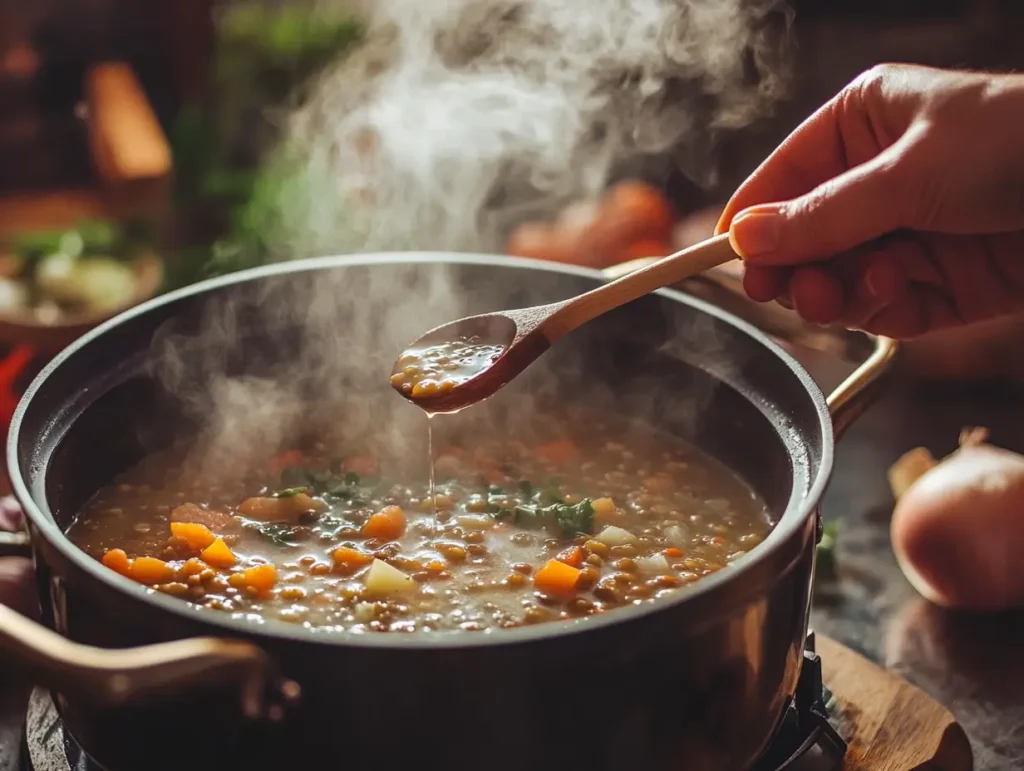Adding vinegar to soup might seem unusual at first, but it’s a culinary trick used worldwide. Why do chefs put vinegar in soup? The answer lies in its ability to balance flavors and enhance the taste of every ingredient. Whether you’re dealing with an overly salty soup or one that tastes a bit flat, understanding why chefs put vinegar in soup can help you transform a dish into something spectacular.
One of the reasons why chefs put vinegar in soup is to fix common flavor issues. For instance, a splash of vinegar can neutralize saltiness or bring brightness to a dull broth. But it’s not just about fixing problems; vinegar also amplifies natural sweetness, enriches umami, and ties all the flavors together. This is precisely why chefs put vinegar in soup as a finishing touch or even during the cooking process.
Knowing which vinegar to use is just as important. Have you ever wondered why chefs put vinegar in soup for different types of recipes? For tomato-based soups, balsamic vinegar adds a sweet depth, while apple cider vinegar complements the richness of bone broths. These specific pairings showcase why chefs put vinegar in soup based on the unique flavor needs of each dish.
Table of Contents
The Role of Vinegar in Soup
Vinegar plays a vital role in balancing the flavors in soup. Its acidity cuts through richness, tempers saltiness, and brings out the subtle notes of other ingredients. Have you ever tasted a soup that felt too heavy or dull? This is where vinegar can work its magic. A small splash can transform a simple broth or creamy soup, making the flavors feel lighter and more vibrant.
For example, imagine you’re enjoying a hearty mushroom soup. While delicious, it might feel overwhelmingly earthy. Adding a teaspoon of white wine vinegar can brighten the flavors, making the soup feel more balanced and enhancing its overall taste. Similarly, in tomato soup, balsamic vinegar smooths out the acidity of the tomatoes while deepening their natural sweetness.

Chefs use vinegar to:
- Balance Saltiness: If a soup is too salty, vinegar can neutralize it, giving the dish a more harmonious flavor profile.
- Enhance Depth: Vinegar amplifies the umami in ingredients like mushrooms, meat, or beans.
- Brighten Dull Flavors: In soups that feel flat, vinegar adds a tangy kick that wakes up the palate.
Transitioning from this, it’s easy to see why vinegar is considered a must-have ingredient in many kitchens. Its ability to unite competing flavors while standing out as a seasoning agent makes it indispensable.
Benefits of Adding Vinegar to Soup
Adding vinegar to soup goes beyond just fixing flavor imbalances. It’s a way to enhance the overall dish in several ways, making it more enjoyable and complex. One of the main benefits is how vinegar acts as a flavor conductor, bringing together all the ingredients in the pot to create a cohesive taste.
- Balances Flavors: Vinegar helps balance the sweet, salty, sour, and umami flavors in soups. For example, in a lentil soup, a touch of red wine vinegar can add complexity without overpowering the earthy taste of the lentils.
- Fixes Saltiness: It’s common to oversalt soup, especially when working with salty broths or seasoning meat-heavy soups. Vinegar can save the day by masking the saltiness, making the soup more palatable without altering its texture.
- Enhances Natural Sweetness: Acidic ingredients like vinegar can highlight the natural sweetness of vegetables, such as carrots or onions, which might otherwise be overshadowed by stronger flavors.
- Boosts Umami: In soups that rely on umami-heavy ingredients like mushrooms, beans, or tomatoes, vinegar amplifies the savory notes, creating a deeper and more satisfying flavor.
For example, let’s say your chicken soup tastes a little too salty or one-dimensional. Adding a small splash of apple cider vinegar will not only reduce the saltiness but also brighten the flavors, making each spoonful more enjoyable.
To bring all these benefits together, it’s clear that vinegar isn’t just an afterthought—it’s an essential tool for crafting the perfect soup.
How Vinegar Balances Flavors in Cooking
To understand why chefs put vinegar in soup, it helps to explore how acidity interacts with other flavors. In cooking, achieving a balance between sour, salty, sweet, and umami is critical. Vinegar, with its tangy acidity, plays a key role in creating this harmony.
The Science of Acidity in Soup
Acidity affects how we perceive flavors. Sour notes from vinegar can counterbalance the richness of creamy soups, reduce the saltiness in brothy soups, and enhance the brightness of vegetable-based soups. For example:
- In a creamy potato soup, sherry vinegar can cut through the heaviness, making the dish feel lighter and more appetizing.
- In a robust black bean soup, a splash of red wine vinegar can amplify the earthy and smoky tones while reducing any bitterness.
This balance is particularly important when dealing with umami flavors. Vinegar sharpens the savory notes, making ingredients like tomatoes, mushrooms, or beef stand out without overwhelming the dish.
For tips on how to elevate bland soups with vinegar, check out our guide on Creative ways to transform bland soup into a flavorful delight.
Types of Vinegar for Different Soups

Choosing the right type of vinegar can make all the difference in your soup. With so many varieties available, it’s important to pair the vinegar with the flavor profile of your soup.
| Type of Vinegar | Best For | Why It Works |
|---|---|---|
| Balsamic Vinegar | Tomato-based soups | Balances acidity while adding a touch of sweetness. |
| Red Wine Vinegar | Lentil soups, hearty stews | Deepens robust flavors and adds complexity. |
| Apple Cider Vinegar | Bone broths, butternut squash soup | Adds a mild tang without overpowering the dish. |
| White Wine Vinegar | Light vegetable soups | Brightens flavors without masking delicacy. |
| Rice Wine Vinegar | Asian-inspired soups like miso or ramen | Subtle acidity complements umami-rich ingredients. |
For example, if you’re making a classic tomato basil soup, balsamic vinegar works wonders by enhancing the tomato’s natural sweetness and mellowing its acidity. On the other hand, apple cider vinegar is perfect for a bone broth, as it helps extract nutrients while adding a slight tang.
How to Add Vinegar to Soup Properly
While vinegar is a powerful flavor enhancer, it’s important to use it correctly to avoid overpowering the dish.
Steps for Adding Vinegar to Soup:
- Start Small: Always begin with a small amount, such as ½ teaspoon, and taste before adding more.
- Timing Matters: Adding vinegar during the cooking process allows it to meld with other flavors. For a sharper effect, add it at the end.
- Balance Is Key: Vinegar should enhance, not dominate, the flavors. Taste frequently as you go.
For additional tips on perfecting both the flavor and texture of soups, check out our guide on Enhancing soup texture and flavor with simple techniques.
Correcting Common Soup Issues with Vinegar

Vinegar is a handy solution for a range of common soup problems.
Fixing Oversalted Soup
Accidentally added too much salt? A teaspoon of vinegar can neutralize the saltiness, saving the dish without requiring additional water or ingredients.
Brightening Bland Flavors
Sometimes, soups can taste flat or one-dimensional. Vinegar adds a pop of brightness that wakes up muted flavors, especially in brothy or vegetable-based soups.
To explore more solutions for balancing soup flavors, visit Proven tips to enhance the taste of homemade vegetable soups.
Alternative Acidic Ingredients for Soups
If you don’t have vinegar on hand, other acidic ingredients can achieve a similar effect. These include:
- Lemon Juice: Great for lighter soups like chicken or vegetable broths.
- Lime Juice: Perfect for spicy soups, such as tortilla or black bean soup.
- Tomatoes: Provide natural acidity while adding a touch of sweetness.
Each of these ingredients offers a unique flavor profile, so choose one that complements your soup’s base.
Tips from Professional Chefs on Using Vinegar
Chefs have long used vinegar as a secret weapon for perfecting soups. Their advice? Always taste and adjust gradually. Professional chefs also recommend pairing vinegar with fresh herbs, such as basil or parsley, to further enhance the soup’s brightness.
For hearty recipes like ham bone soup, learn how vinegar adds depth by visiting Adding depth to hearty soups with expert flavoring tricks.
Conclusion
Vinegar might not be the first ingredient you think of when making soup, but its ability to balance and elevate flavors is unmatched. Whether you’re fixing an overly salty dish, enhancing natural sweetness, or simply looking to add depth, a splash of vinegar can transform your soup into something truly special. Experiment with different types of vinegar to find your favorite combinations, and don’t be afraid to get creative.
FAQs
Why Add Vinegar to Soup?
Vinegar is added to soup because of its unique ability to balance flavors and enhance the overall taste. Its acidity helps neutralize excessive saltiness, brighten dull flavors, and bring depth to savory ingredients. A splash of vinegar can also highlight the natural sweetness of vegetables or amplify the umami in rich broths. It acts as a flavor conductor, harmonizing all the components of the soup to create a cohesive and satisfying dish.
For example, in a heavy cream-based soup like potato or butternut squash, vinegar cuts through the richness, making the soup feel lighter and more balanced. In contrast, for tomato-based or hearty bean soups, it deepens the flavor while taming the acidity of the tomatoes.
What Is the Best Vinegar for Soup?
The best vinegar for soup depends on the type of soup you’re making. Here are some popular options:
Apple Cider Vinegar: Ideal for bone broths, butternut squash, or vegetable soups due to its mild tang and versatility.
Balsamic Vinegar: Perfect for tomato-based soups or hearty stews because it adds sweetness and depth.
Red Wine Vinegar: Works well with lentil soups, beef broths, or other robust dishes, as it complements earthy and savory flavors.
White Wine Vinegar: Great for light soups like minestrone or spring vegetable soups because it adds brightness without overpowering delicate flavors.
Rice Vinegar: Excellent for Asian-inspired soups like miso or ramen, as its subtle acidity pairs well with umami-rich ingredients.
Selecting the right vinegar ensures the flavors complement rather than clash, enhancing the soup’s overall taste.
Why Do You Put Balsamic Vinegar in Soup?
Balsamic vinegar is added to soup because of its ability to balance acidity and sweetness. In tomato-based soups, balsamic vinegar smooths out the sharp tang of the tomatoes while enriching their natural sweetness, creating a more complex and satisfying flavor.
Additionally, balsamic vinegar has a unique, slightly syrupy consistency that adds depth and richness to hearty soups like stews or bean-based dishes. Its bold flavor works especially well in recipes where a touch of sweetness complements the overall profile, such as in tomato basil soup or Italian-inspired minestrone.
What Type of Vinegar to Use in Soup?
The type of vinegar to use in soup depends on the soup’s flavor profile and your desired outcome. Here are some guidelines:
Apple Cider Vinegar: For mild, slightly fruity acidity, perfect in broths or vegetable soups.
Red Wine Vinegar: Best for rich, hearty soups like beef stew or lentil soup.
Balsamic Vinegar: Adds a sweet and tangy depth to tomato-based or Italian-style soups.
White Wine Vinegar: For a crisp and clean tang that pairs well with lighter soups.
Rice Vinegar: A subtle, slightly sweet option for Asian-inspired soups like miso or pho.
When choosing vinegar, think about the soup’s ingredients and the balance you want to achieve. Each type of vinegar brings a distinct flavor that can elevate your dish.

